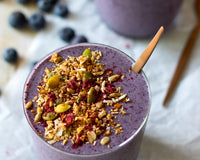How can we survive in a toxic world?

I think that’s a question we’re likely to hear more and more often. In fact, I first asked myself that very same question after the birth of my first child. In general, we tend to give much less thought to the things we do for ourselves than to our actions that affect loved ones. So, it was only when my son was born that I realized how more and more “toxic” products are being sold and that it’s not always easy to make good food choices. From fruits and vegetables to animal products, nuts, and so many other things, globalization has changed the way we eat.
As I often say, we should always eat foods in their most unprocessed form. But, to eat this way, we have to recognize that in nature foods aren’t always attractive and perfectly shaped and that they have less shelf-life once picked.
We must also to get back to a style of farming that gives us easy frequent access to foods, and direct traceability from farm to table. This way, we know where the food on our plate comes from and we can go visit the farmer who grew it.
This is the future.
And, strangely enough, the future is a reflection of the past: it’s how things were in our grandparents’ and great-grandparents’ day.
They lived for forty or fifty years without pesticides, whereas our generation will never know anything but the toxic world we were born into. Obviously, medicine is more advanced now, with access to medications and certain procedures that didn’t exist in their time.
But the choices we make are very important.
We must choose independently certified organic products as often as possible. But, more than that—because there’s a lot of marketing involved and we can’t always personally verify food sources—we have to buy local as often as possible.
Buying local is all the rage these days, and justifiably so! A lot of producers work very hard to do things right, and it’s important to know where to find them. A growing trend is to sign up for weekly organic vegetable deliveries. This service is offered by certain local farmers, with meat producers starting to follow suit. A quick Google search will yield a list of suppliers. So, no more excuses if you don’t have time to take a trip to the farm!
In my opinion, buying local is the way of the future, and I encourage everyone to try it.
Of course, budget and cost can often be considerations when buying organic. A good idea is to start slowly, targeting a few organic foods in particular, and to continue buying non-organic for the rest. Any fruit or vegetable with a thick skin that can be peeled is a lesser of evils. Take avocados, for example. Eating an organic avocado is a good move, but it won’t make as big a difference to your health as eating organic strawberries. You can’t peel strawberries, and rinsing them removes almost no contaminants.
The same principle applies to meat.
Bison, for example, roams freely and grazes on long grass. Its fat will contain much higher levels of omega-3 and tend to be more yellow in colour that conventionally raised beef. So, you’re better off choosing leaner cuts if you’re going to eat conventional meat because pesticides and antibiotics are stored in the animals’ fat.
A healthy animal that hasn’t been given antibiotics or eaten pesticide-laden feed will have healthy fat that doesn’t contain toxins.
The lesser the quality of the meat we buy, the more we should eat leaner cuts to ingest the fewest toxins. Even though you can’t eliminate all toxins, reducing them is still the best option for your health.
Pesticides and antibiotics affect the body in different ways.
Certain components of pesticides and herbicides can have a toxic effect on our body, becoming carcinogenic over time as they accumulate.
As for antibiotics, some bacteria are increasingly becoming resistant to antibiotics. Although we still can’t say for sure, one explanation of this phenomenon is that regularly eating antibiotic-treated meat makes us resistant to certain antibiotics. Scientists are working hard to get to the bottom of whether this might make treating infectious diseases more difficult and whether we’ll need a much larger arsenal of medications in the future.
But, do not panic!
The human body is made to detoxify itself. We wouldn’t be here now without this capacity. The liver, kidneys, skin, intestines and lungs are all organs that flush out waste and toxins from our body. Some people don’t believe in detoxes or cleanses, but often they don’t understand what these cleanses do. The point of a cleanse isn’t to compensate for something the body is unable to do on its own. Rather, it is to lighten the load on our organs by eliminating more toxins and so allow them to work more efficiently. People may scoff, but in my and my colleagues’ experience, the results speak for themselves.
As I often say, we should always eat foods in their most unprocessed form. But, to eat this way, we have to recognize that in nature foods aren’t always attractive and perfectly shaped and that they have less shelf-life once picked.
We must also to get back to a style of farming that gives us easy frequent access to foods, and direct traceability from farm to table. This way, we know where the food on our plate comes from and we can go visit the farmer who grew it.
This is the future.
And, strangely enough, the future is a reflection of the past: it’s how things were in our grandparents’ and great-grandparents’ day.
They lived for forty or fifty years without pesticides, whereas our generation will never know anything but the toxic world we were born into. Obviously, medicine is more advanced now, with access to medications and certain procedures that didn’t exist in their time.
But the choices we make are very important.
We must choose independently certified organic products as often as possible. But, more than that—because there’s a lot of marketing involved and we can’t always personally verify food sources—we have to buy local as often as possible.
Buying local is all the rage these days, and justifiably so! A lot of producers work very hard to do things right, and it’s important to know where to find them. A growing trend is to sign up for weekly organic vegetable deliveries. This service is offered by certain local farmers, with meat producers starting to follow suit. A quick Google search will yield a list of suppliers. So, no more excuses if you don’t have time to take a trip to the farm!
In my opinion, buying local is the way of the future, and I encourage everyone to try it.
Of course, budget and cost can often be considerations when buying organic. A good idea is to start slowly, targeting a few organic foods in particular, and to continue buying non-organic for the rest. Any fruit or vegetable with a thick skin that can be peeled is a lesser of evils. Take avocados, for example. Eating an organic avocado is a good move, but it won’t make as big a difference to your health as eating organic strawberries. You can’t peel strawberries, and rinsing them removes almost no contaminants.
The same principle applies to meat.
Bison, for example, roams freely and grazes on long grass. Its fat will contain much higher levels of omega-3 and tend to be more yellow in colour that conventionally raised beef. So, you’re better off choosing leaner cuts if you’re going to eat conventional meat because pesticides and antibiotics are stored in the animals’ fat.
A healthy animal that hasn’t been given antibiotics or eaten pesticide-laden feed will have healthy fat that doesn’t contain toxins.
The lesser the quality of the meat we buy, the more we should eat leaner cuts to ingest the fewest toxins. Even though you can’t eliminate all toxins, reducing them is still the best option for your health.
Pesticides and antibiotics affect the body in different ways.
Certain components of pesticides and herbicides can have a toxic effect on our body, becoming carcinogenic over time as they accumulate.
As for antibiotics, some bacteria are increasingly becoming resistant to antibiotics. Although we still can’t say for sure, one explanation of this phenomenon is that regularly eating antibiotic-treated meat makes us resistant to certain antibiotics. Scientists are working hard to get to the bottom of whether this might make treating infectious diseases more difficult and whether we’ll need a much larger arsenal of medications in the future.
But, do not panic!
The human body is made to detoxify itself. We wouldn’t be here now without this capacity. The liver, kidneys, skin, intestines and lungs are all organs that flush out waste and toxins from our body. Some people don’t believe in detoxes or cleanses, but often they don’t understand what these cleanses do. The point of a cleanse isn’t to compensate for something the body is unable to do on its own. Rather, it is to lighten the load on our organs by eliminating more toxins and so allow them to work more efficiently. People may scoff, but in my and my colleagues’ experience, the results speak for themselves.
Have a great trip to the grocery store!





